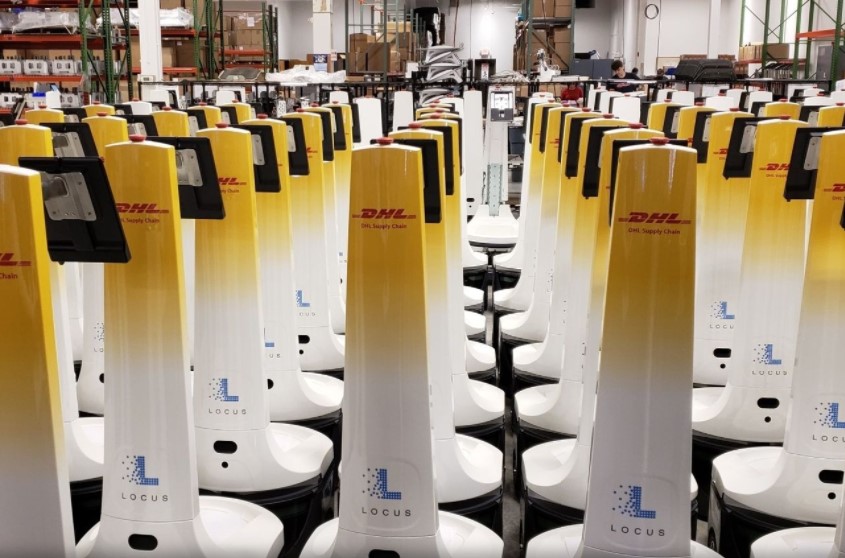Assisted picking bots at a DHL Supply Chain facility. The unit of Deutsche Post increased its focus on automating operations to meet surging demand and keep workers safe.
PHOTO: DEUTSCHE POST DHL GROUP
WSJ — Wall Street Journal
Angus Loten
Sept. 20, 2021
Experienced CIOs expected to see average annual salaries of $260,250 in 2022, up 2.7% from 2021, according to recruiting firm Robert Half
The Covid-19 pandemic has supercharged the role of chief information officers, accelerating a shift from backroom technicians to front-office decisionmakers, as companies’ operations are increasingly shaped by technology.
CIOs and other corporate technology leaders over the past year found themselves in greater positions of leadership, taking a critical role in facilitating the shift to remote work, reconfiguring supply chains, speeding up the automation of factories, and moving stores and restaurants online, executives and industry analysts say.
CIOs also had a hand in strengthening the security and resilience of their companies which was tested this year as never before as the shift to remote work and collaboration tools opened new vulnerabilities for hackers.
“We’ve seen years worth of adoption jammed into just months,” said Capital One Financial Corp. CIO Rob Alexander.
“It’s critical for today’s technology leaders to be well rounded business leaders, with deep expertise across multiple disciplines, and a growth mind-set,” Mr. Alexander said.
The growing influence of CIOs over core areas like finance, sales and marketing that have come to rely on software has led to bigger budgets, added job titles like executive vice president, a seat in the boardroom-and fatter paychecks.
Chief information officers with above average skills and experience are expected to draw average annual salaries of $260,250 in 2022, up 2.7% from 2021, after rising 0.5% this year from 2020, according to data provided by recruiting firm Robert Half International Inc. Other enterprise technology executives are seeing similar gains, the firm said.
By contrast, salaries for chief financial officers-who CIOs often report to-are expected to rise 0.3% next year, to $242,000, the firm said.
Ryan Sutton, a district president at recruiting firm Robert Half’s technology division, said the pandemic forced enterprise tech leaders to tackle unexpected challenges with an expanded IT tool kit.
Led by CIOs, he said, tech initiatives that were planned as a slow transition over the next few years-like moving the software systems for accounting, sales, marketing and other business units into the cloud-shifted into the fast lane and fell under the purview of a CIO:
“That’s making them more valuable.”
Markus Voss, chief information officer and chief operations officer at DHL Supply Chain, a unit of global logistics giant Deutsche Post AG, said when Covid-19 struck he was tasked with running global operations on top of overseeing day-to-day information technology.
The added responsibilities came amid surging demand for parcel deliveries, he said. It included oversight of roughly 2,200 warehouses and other facilities spread around the world.
“We pushed even harder on further digitizing and automating our operations,” Mr. Voss said.
Among other initiatives, he ramped up the use of robots and other automated systems to safeguard workers and track inventories.

Markus Voss, chief information officer at DHL Supply Chain.
PHOTO: DEUTSCHE POST DHL GROUP
In addition to pay, corporate budgets overseen by CIOs are on the rise.
Worldwide enterprise IT spending is expected to hit $4.2 trillion by the end of the year, up 8.6% from 2020, according to IT research and consulting firm Gartner Inc.
To keep pace with a surge in online banking, Capital One is investing heavily on a range of digital capabilities, building on past spending on cloud services, software, and talent, with plans this year to hire some 3,000 software, data and machine-learning engineers, cybersecurity experts and other tech workers, Mr. Alexander said.
Scott Spradley, executive vice president and chief technology officer at Tyson Foods Inc., said the pandemic pushed the meatpacking giant to sharpen its focus on data-based insight and decision-making systems.
- That includes ramping up its use of data to better predict sudden demand changes,
- while taking a more aggressive approach to deploying automation and robotics, he said.
Tyson and other large meatpackers were hit especially hard by the pandemic, with outbreaks among workers leading to temporary plant shutdowns.
More CIOs are also getting named to corporate boards, adding vice president or executive vice president to their titles.
“Technology comes up in board discussions all the time, and the pandemic accelerated that even further, giving CIOs much more exposure to the board,” said Chuck Gray, partner and head of U.S. Technology Officers Practice at management consulting firm Egon Zehnder.
Mr. Gray said one corporate tech leader recently told the firm that before the pandemic he used to present to the board a few times a year, and at the start of the Covid-19 crisis it became every week:
“An upshot of this additional exposure is that more CIOs are now getting board seats,” he said.
“We’ve had to navigate the impact of the coronavirus as it introduced a new layer of complexity,” said Nancy Anderson, CIO of General Electric Co.,
citing both internal and external challenges in enabling workers to get day-to-day tasks done, while finding new ways to deliver products and services to customers.
She said CIOs should seize the opportunity to identify even more areas where technology can be put to use.
Jennifer Hartsock, CIO of energy firm Baker Hughes Inc., said even before Covid-19, enterprise IT chiefs were getting a bigger seat at the executive leadership table.
She said her own role expanded during the pandemic,
- from a focus on internal technology integrations,
- to providing digital capabilities to support remote and hybrid work models.
“CEOs and boards are recognizing how digital cannot be separated from business objectives,” Ms. Hartsock said.
Originally published at https://www.wsj.com on September 20, 2021.
Names cited:
Rob Alexander, Capital One Financial Corp. CIO;
Ryan Sutton, a district president at recruiting firm Robert Half’s technology division;
Markus Voss, chief information officer and chief operations officer at DHL Supply Chain, a unit of global logistics giant Deutsche Post AG;
Scott Spradley, executive vice president and chief technology officer at Tyson Foods Inc.;
Chuck Gray, partner and head of U.S. Technology Officers Practice at management consulting firm Egon Zehnder;
Nancy Anderson, CIO of General Electric Co.;
Jennifer Hartsock, CIO of energy firm Baker Hughes Inc.,












